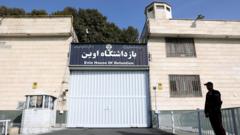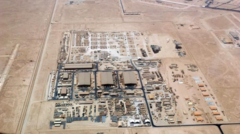The U.S. president touted a cease-fire between Israel and Iran amid an intensifying missile exchange, yet Iranian officials quickly denied any such agreement, questioning the reliability of Trump's claims. Violence continues as tensions heighten, raising fears of a broader regional conflict.
Tensions Mount as Cease-Fire Discussions Flounder Amid Continued Attacks in the Middle East

Tensions Mount as Cease-Fire Discussions Flounder Amid Continued Attacks in the Middle East
As President Trump announces a potential cease-fire between Israel and Iran, conflict escalates with missile strikes from both sides, leaving diplomacy hanging by a thread.
June 24, 2025, 4:34 a.m. Jerusalem - Reports circulating late Monday suggested that President Trump was optimistic about a cease-fire between Israel and Iran after a tumultuous exchange of missile strikes. However, Iranian officials swiftly countered, asserting that no agreement was in place as they launched further attacks.
Tensions intensified throughout the Middle East, with missile attacks reported near key military installations. The situation became increasingly precarious when Iran targeted Al Udeid Air Base in Qatar— the largest U.S. military base in the region—prompting fears that this could escalate into a wider conflict.
Videos showcasing missiles lighting up the night sky were shared globally, while graphics revealed the profound destruction wrought by ongoing strikes. Amidst the rising chaos, U.S. military operations continued in response to Iranian attacks, with air defenses successfully intercepting a barrage of missiles aimed at American troops.
In light of the turbulent events, Trump cited a potential path to peace and emphasized the need for stopping hostilities. "We can achieve a Complete and Total CEASEFIRE," he declared on social media, suggesting deadlines that experts find nebulous. Meanwhile, Iranian officials indicated a willingness to cease actions if Israel hesitated from continuing its airstrikes.
Even with diplomatic overtures made by Qatari officials seeking to mediate between the two nations, the uncertain atmosphere was punctuated by fresh threats from Trump's administration, asserting that military actions would be a continued possibility if Iran persisted in its nuclear ambitions.
Reports from European diplomats echoed the sentiments of the U.S. administration, indicating that without a diplomatic resolution, violence could spiral into uncontainable destruction. As negotiations stutter and violence ramps up, the fragile agreements sought by numerous intervening parties remain elusive, leaving regional stakeholders pressing for a return to stability.
Tensions intensified throughout the Middle East, with missile attacks reported near key military installations. The situation became increasingly precarious when Iran targeted Al Udeid Air Base in Qatar— the largest U.S. military base in the region—prompting fears that this could escalate into a wider conflict.
Videos showcasing missiles lighting up the night sky were shared globally, while graphics revealed the profound destruction wrought by ongoing strikes. Amidst the rising chaos, U.S. military operations continued in response to Iranian attacks, with air defenses successfully intercepting a barrage of missiles aimed at American troops.
In light of the turbulent events, Trump cited a potential path to peace and emphasized the need for stopping hostilities. "We can achieve a Complete and Total CEASEFIRE," he declared on social media, suggesting deadlines that experts find nebulous. Meanwhile, Iranian officials indicated a willingness to cease actions if Israel hesitated from continuing its airstrikes.
Even with diplomatic overtures made by Qatari officials seeking to mediate between the two nations, the uncertain atmosphere was punctuated by fresh threats from Trump's administration, asserting that military actions would be a continued possibility if Iran persisted in its nuclear ambitions.
Reports from European diplomats echoed the sentiments of the U.S. administration, indicating that without a diplomatic resolution, violence could spiral into uncontainable destruction. As negotiations stutter and violence ramps up, the fragile agreements sought by numerous intervening parties remain elusive, leaving regional stakeholders pressing for a return to stability.





















